Situated on the Indian Ocean coast 485KM north of Perth, Kalbarri National Park is a diverse arid region with magnificent ocean cliffs, inland gorges and the Murchison River that flows into the sea at the small seaside town of Kalbarri.
Driving south on the Northwest Coastal Highway from our last camp at Denham delivered an unexpected surprise. Mulga scrub and acacia spread out over flat sandy plains with spring flowers lining the roadside gradually gives way to larger shrubs, and Spotted River Gums. The surrounding landscape starts to undulate with winding roads and then, all of a sudden, cresting a hill, there is a total and unexpected change of scenery. Gone are the Mulga plains and dense bush, the wild flowers and trees. We have suddenly arrived in the rolling hills of the Wheatbelt. It’s almost like a summer scene in England with golden fields ready for harvesting. Quite surreal.
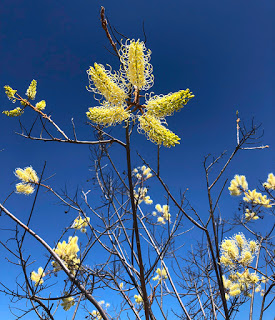
Smelly Socks
Just as suddenly had we arrived among the fields a turn to the left took us back into the sand plains and on to Kalbarri National Park. Along much of the road wildflowers were in bloom and one in particular stood head and shoulders, literally, above the others.
Among the last in the season to flower, the White Plume Grevillia has pale cream flowers on the ends of long stalks growing from the lower grevillia shrub. A sickly sweet scent is released at dusk and in the evening to attract insects. Its common name very aptly describes its appearance and odour – ‘smelly socks’.
Our first visit into the park took us through classic Mulga territory with the occasional Grass trees and Sandplain Cypress trees standing above the acacias. Wild flowers are again dotted along the side of the road in clumps of yellow, white, orange, red and blue. It is towards the end of the wildflower season now but nature is still putting on a show.
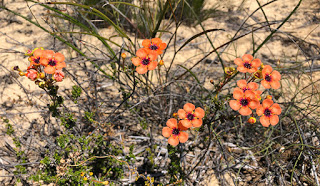
Nature’s Window
We had planned several walks in the park and our initial destination was a rock formation known as Nature’s Window, which stands on top of a gorge wall overlooking a large bend in the partially dry Murchison River 100-metres below. From the car park a set of steps lead down to a tarmac path where you’re likely to be greeted by extremely irritating flies. It’s for good reason many people walking this trail are wearing fly nets, something we should have thought about and will keep with us in future.
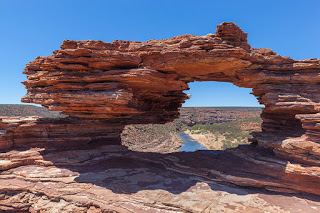
The trail leads downhill through Mulga shrubs to a small lookout and rest stop with views down into the gorge and along the river. A short stroll further on and the trail becomes a scramble over striped rocky ledges formed from ancient sea floor sediments with ripples still clearly visible in many places. There are a few exposed locations with drops into the gorge that are best avoided, for obvious reasons, and a small stepped rock climb upwards and you find yourself standing right by Nature’s Window.
Weathering of the soft sandstone has created a framed rock hole with views down to the river and along the gorge. Looking quite delicate in places, it has been advised that taking a selfie within the frame is not recommended practice but people still do. And they’re most likely of the thong wearing brigade.
A loop walk continues along the edge of the gorge for 8KM but the flies were too persistent for us to carry on any further.
Kalbarri Skywalk
High up to the left overhanging the gorge are two prominences – both man made. When complete they will form cantilevered lookouts 100-metres above the river. The project, known as the Kalbarri Skywalk, was due for completion in mid-2019 but now in mid-October the $20-million project is clearly way behind and looks unlikely to open before the end of summer 2020.
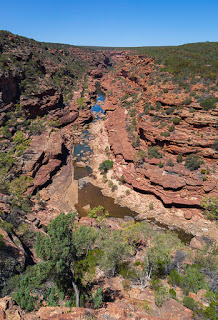
Z-Bend Lookout
Our second walk, 11KM to the south, took us to the Z-Bend Lookout. A well maintained gravel track leads through the bush to a view into the gorge along a natural fault line that is responsible for the z-shaped path the Murchison River takes here.
The rock fractures caused by the fault have created an easy straight path for water to flow and erode rather than the smooth rounded bends more normally associated with rivers cut through valleys and gorges. The result is the angled changes of direction of the river and in this case taking the shape of the letter ‘Z’.
For those wanting more of a challenge, and ideally with an accompanying fly net, a nearby track leads down into the gorge and along the 6KM path known as the Four-Ways Trail.
Scorpions
Just before the lookout a display board shows a large, life-sized image of an ancient sea scorpion, a creature you wouldn’t want to step on while walking in the shallows. Beside the sign is a number of fossilised trackways created by this hand-sized crustacean and frozen in time nearly 400-million years ago.
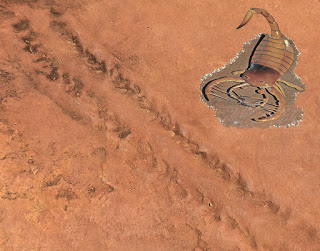
It is believed this creature was one of the very first to transition from the sea to land at a time when plants and grasses were still to appear.
Enough with the FLIES
Having had enough of the flies we decided to head to the coast, still within Kalbarri National Park. Nine sealed roads lead to a number of easily accessible lookouts over the blustery Indian Ocean.
We started with a trip to Island Rock 16KM south of Kalbarri town, which leads to amazing views of the ocean but it is only after leaving the car and taking a short stroll along the sealed path that you get a full view of the magnificent, almost white, sandstone cliffs. These are the most dramatic cliffs we have seen in the six-months of our travels through four-States. Easily the most arresting sight so far and looking very similar to many of the rugged coastlines of the UK.
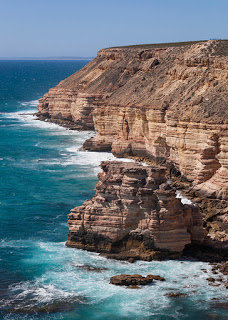
Island Rock
As its name suggests Island Rock was once part of the Tumblagood sandstone cliffs but erosion by wind and waves has undercut the rock finally isolating it to form a sea stack. While walking further along the path towards the next viewpoint I spotted a tiny dragon and managed to snap a few photographs before it dived for cover. It was a new one to us – a Mallee Military Dragon and just 6-centimetres long.
Natural Bridge
The strong wind whipping-up the sea and smashing wave after wave against the rocks makes this site all the more impressive. None more so than at Natural Bridge where the waves have eaten away at the cliff leaving a harder section of rock protruding into the sea. Over time, continuing erosion has removed rock along the base until collapsing layers have left a bridge linking the rock to the cliff. Eventually, though, the span of the bridge will collapse leaving a second Island Rock.
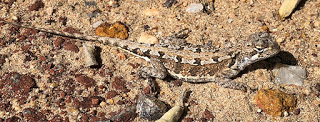
Snake!!
While taking photos of the the scenery I turned and noticed a sizeable and highly patterned snake cross the path into the scrub. Catherine went to take a closer look as I swapped lenses and followed. The snake was partially among the branches of a low-laying acacia but I managed to fire off a shot before it took cover further away. A beautiful looking creature but it wasn’t until the evening before we identified it – a Mulga snake, also known as a King Brown and highly dangerous.

Unlike the Brown snake the King Brown isn’t aggressive but it will defend itself when cornered. Its venom isn’t as toxic either but it is the quantity, 10-times that of the Brown snake, that does the serious damage. And neither does it give a quick bite and run instead hanging on with a chewing action to ensure the recipient receives the maximum dose.
Despite its name the King Brown is not related to the Brown snake at all, it belongs instead to the Black snake family. It has a venom of unusual qualities that is being extensively researched. Rather than aggressively attack the nervous system or the heart, the King Brown’s venom principally targets striated muscle tissue, those in the legs of most walking creatures and preventing its prey from running away. It also, like many snake venoms, causes blood cells to rupture. A second novelty are two antibacterial agents that are active against the bacteria found in its most common form of prey – amphibians and reptiles. Not only does it keep its incapacitated prey alive it is also able to protect itself from bacterial infection. Now that’s a clever bit of evolution.
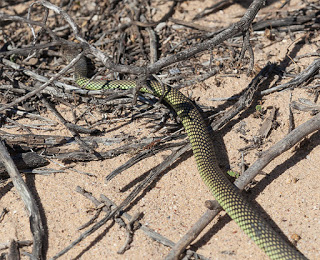
Recent research into the snake venom’s antibacterial properties has shown one isolated antibacterial agent is seventy times more effective than current drugs and it is hoped this could lead to a solution for the increasingly drug resistant strains of bacteria, the so called Super Bugs.
It’s quite ironic that a creature that strikes abject fear into so many people could one day help save their lives.
Kalbarri, the National Park and the ‘must see’ spectacular coastline have been quite a surprise. Add to that the unexpected wildlife and the wild flowers that we thought we had missed being this late in the season. We still have one more walk to do later in the week and I suspect that will throw yet more surprises. We’ll also be taking our fly nets along!
